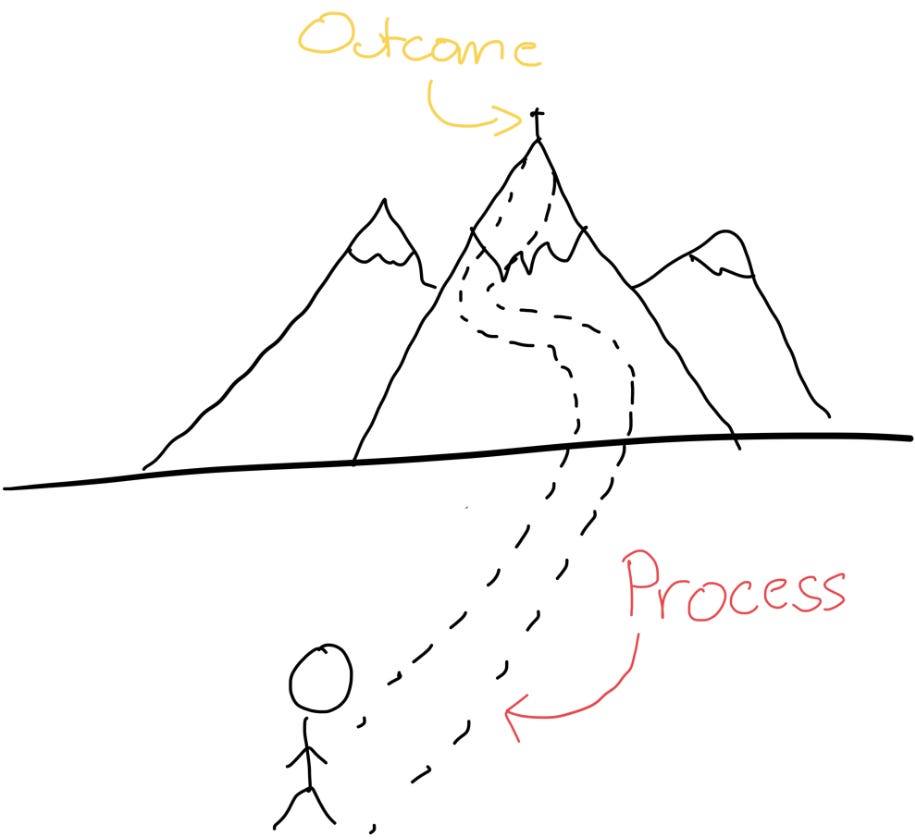Goal Setting Got You Stuck? Here is Your Cue to Shift Focus
Outcome goals set the destination, but process goals build the road. Here’s how to get started.
While scrolling through social media at the end of 2024, it became evident to me that most apps and services hopped onto the “wrapped” trend. For the uninitiated, Spotify kicked this off in 2016 with a personalized recap of your year in music—complete with stats and flashy graphics. They might not have been the first to do it, but they were the first to make it go viral, with people sharing their recaps all over social media. Fast forward to 2024, and now every platform seems to have its own version—Strava, Reddit, Duolingo, Steam, you name it.
But here’s what stood out to me: most of these wrap-ups end with a page full of numbers, rankings, and subtle hints that you should do more next year to climb higher. It’s a not-so-gentle nudge to have you do more the next year.
When Numbers Overshadow Context
Looking at this through a fitness lens, it’s easy to see how people often set next year’s goals based on doing more than last year—usually with a nice, round number like running 2,000 kilometers or climbing 50,000 meters.
This mirrors how we traditionally set goals in running. We’ve all heard of the classic milestones: a 20-minute 5K, a 40-minute 10K, a 1:30 half marathon, or a 3-hour marathon. Even pros are measured by similar benchmarks.
Naturally, us amateurs—who run for fun—tend to adopt these same kinds of goals. We aim to finish a race in a specific time or complete our longest distance yet. But I’ve always found this approach a bit too rigid. What if I run my goal marathon in 3:00:27, but the weather was brutal—does that count as a success or a failure? With such black-and-white goal-setting, is there even room for partial success?
When Goals Meet Reality
Every June, Salzburg hosts the Mozart100, a UTMB race many treat as their A-race for the year. But the 2024 edition will be remembered for its brutal weather. Constant rain turned the trails into a slippery mess, demanding extra physical and mental effort from every runner.
I was volunteering at the third aid station, around 30km in and just after the first major climb and descent. The first 500 meters of downhill are notoriously technical, and in training, I’d nearly face-planted multiple times. With conditions like these, I knew even the best runners would struggle—and I was right.
I tried to help refill bottles and offer encouragement, but so many runners were done. They’d only covered 30km, yet the conditions had broken them. The DNF rate—voluntary or due to time limits—was staggering. Some had traveled across the globe only to quit a third of the way in.
Among my friends, the DNF rate was 50%, matching the overall field. Compared to the 80% finish rate the year before, it was clear that the weather affected many runners. Most who finished missed their goal times by hours. By the numbers, they failed—but in context, every finisher was a success. So, does missing a time goal really mean failure?

The Limitations of Outcome Goals
Outcome goals are all about the end result. They focus squarely on a specific achievement, treating it as the ultimate measure of success. These goals are often black-and-white and tied to numbers.
However, they miss nuance and context. Life’s unpredictable factors—stress, injuries, bad weather, or even an airline losing your luggage—can derail even the best-laid plans. Sure, you can plan for some of these, but the rigid nature of outcome goals means luck plays a big role in hitting ambitious targets.
Using outcome-based standards, runners who failed to hit their time goal “failed.” But let’s be real—that’s an overly harsh way to judge their effort. Unfortunately, that’s how outcome goals work: they leave little room for the messy, unpredictable parts of life.
A Process-Driven Path to a Successful Outcome
Remember when you were 13, posting “motivational” quotes on social media like you were the next Dalai Lama (or David Goggins 😉)? One of those posts probably looked something like this:
Well, I’m here to tell you that 13-year-old you might have been onto something. While outcome goals focus solely on the end result, process goals shine a light on—you guessed it—the process.
Instead of fixating on a single, rigid target, process goals look more like this:
“I want to focus on nutrition during training to reduce race-day stomach issues.”
“I want to build confidence on technical downhills.”
“I want to do solo night runs to feel more comfortable running alone in the dark.”
Process goals break the big picture into smaller, manageable steps. Each one gets you closer to your ultimate goal, but here’s the best part: they depend almost entirely on you and the choices you make during training. No more relying on luck—just focus, persistence, and a clear plan.
Your Inner Judge: The True Arbiter of Success
The first response I always get when explaining this concept is, “Aren’t these just soft goals? They’re hard to track and easy to call a success.” My answer? That’s exactly why they’re so powerful.
Process goals are personal. What counts as success for you might not mean the same to someone else. Sure, you could tell people that you crushed your goals this year, but deep down, you know when you’ve truly achieved them—and that’s what makes these goals so effective.
Unlike outcome goals, process goals are tailored to you and what you want to achieve. Yes, that means you’re the one judging your success, but let’s be honest: most of us have an inner voice that’s pretty good at calling us out when we fall short.
So no, I don’t think process goals are soft or easy wins. In fact, their personal nature—combined with the fact that most people hold themselves to high standards—creates a mindset that’s far more intentional and, ultimately, more effective.
When Process Isn’t Enough
Unfortunately, the world doesn’t run on intentions—it demands results. Let’s take what we’ve learned and apply it to a real-world scenario: someone who’s lost their job.
Rent and utilities can’t be paid with good intentions; you need a job, and that’s your clear outcome goal. But the job market is unpredictable. You might be limited to a specific area with few opportunities, or you might have no idea why you’re being passed over for roles. So, how do you stay motivated? By focusing on process goals;
Research the company and role thoroughly before each interview.
Identify areas where you struggled in past interviews and work on improving them.
After each rejection, ask for feedback to uncover blind spots and grow from the experience.
While this isn’t a post about job hunting, this example shows how breaking down an outcome into smaller, process-oriented goals can help you stay in control and move closer to your target.
That said, outcomes still matter. If you’re consistently hitting your process goals but missing your outcome goals, something’s off. Maybe your process isn’t aligned with your end goal, or maybe you’re being too lenient when judging your progress. In that case, it’s worth bringing in a trusted friend or coach to help keep you honest and on track.

Bringing It All Together
Hopefully, this post has given you a better understanding of process-based goal setting and some guidance on shifting your focus from the end result to the steps needed to get there. By focusing on the process, you regain control, set healthier goals, and increase your chances of actually achieving them.
I’ve got two more posts coming up that dive deeper into this idea, specifically for long-distance running, so stay tuned!
Who am I?
Hi, I’m Niki—a Maltese 🇲🇹 long-distance trail runner now based in Salzburg, Austria 🇦🇹.
Over the years, I’ve had the amazing chance to run in some incredible races around the world, like the 2023 Backyard Ultra Individual World Championships, CCC, and the Mozart 100 by UTMB. Along the way, I’ve learned so much that I think could help others on their trail and ultra-running journeys. That’s why I decided to start this blog—to share those tips and experiences in one place.
If you enjoy this post, feel free to share it with your friends or subscribe (as a free or paid supporter) to stay updated whenever there’s something new. You can also connect with me on social media—I’d love to hear from you!





